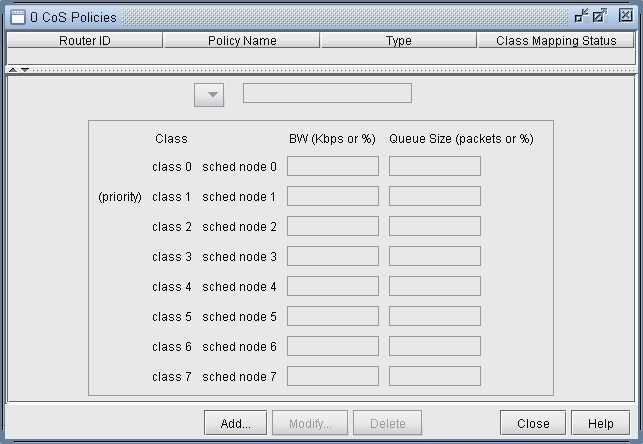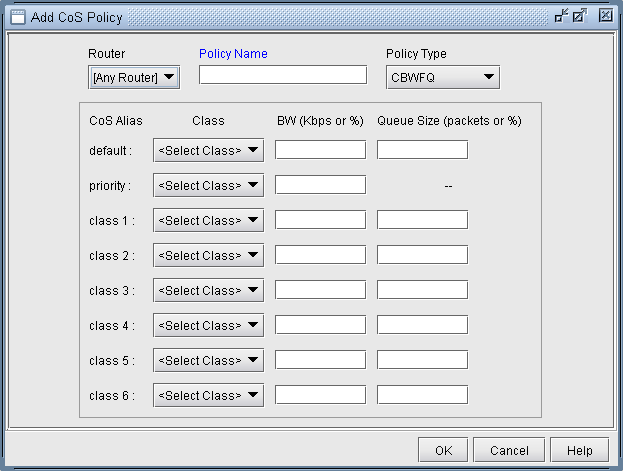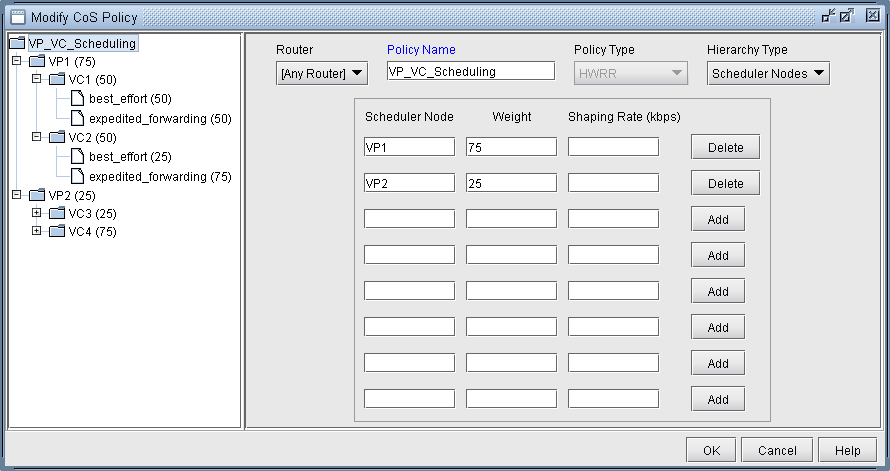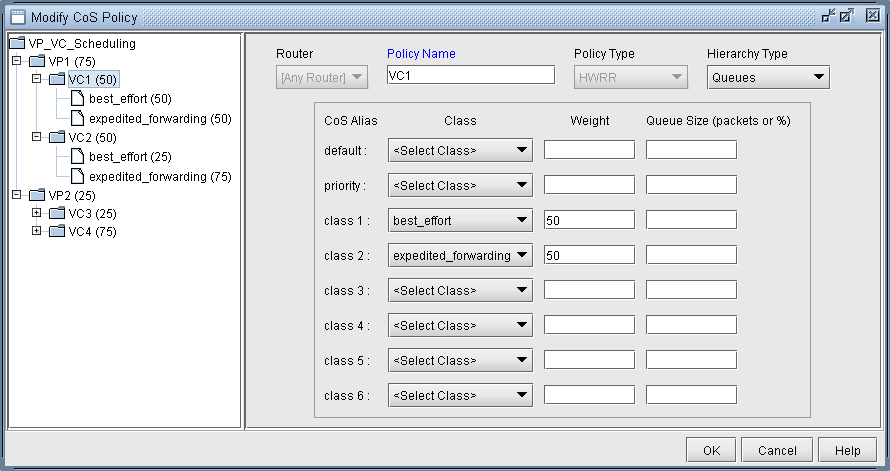- play_arrow Introduction
- play_arrow Router Data Extraction
- play_arrow Routing Protocols
- play_arrow Equal Cost Multiple Paths
- play_arrow Static Routes
- play_arrow Policy-Based Routes
- play_arrow Border Gateway Protocol
- NorthStar Planner Border Gateway Protocol Overview
- Border Gateway Protocol Recommended Instructions
- BGP Data Extraction
- BGP Reports
- BGP Options
- BGP Map
- BGP Live Status Check
- BGP Routing Table
- BGP Routes Analysis
- BGP Information at a Node
- BGP Neighbor
- Apply, Modify, or Add BGP Polices
- BGP Subnets
- Getipconf Usage Notes
- BGP Report
- play_arrow Virtual Private Networks
- NorthStar Planner Virtual Private Networks Overview
- Import VPN Information from Router Configuration Files
- Viewing the Integrity Checks Reports
- Accessing VPN Summary Information
- Accessing Detailed Information for a Particular VPN
- VPN Topology View
- Route-Target Export/Import Relationships
- Additional Methods to Access VPN Information
- VPN Path Tracing
- VPN Design and Modeling Using the VPN Wizard
- L3 (Layer 3) VPN
- L3 Hub-and-Spoke VPN
- L2M (Layer2-Martini) VPN
- L2K (Layer2-Kompella) VPN
- VPLS-BGP VPN (for Juniper)
- VPLS-LDP VPN
- L2CCC (Circuit Cross-Connect) VPN
- Inter-AS VPN
- Forming VPN Customer Groups
- Deleting or Renaming VPNs
- VPN Configlet Generation
- Adding Traffic Demands in a VPN
- VPN Traffic Generation
- VPN-Related Reports
- VPN Monitoring and Diagnostics
- play_arrow GRE Tunnels
- play_arrow Multicast
- NorthStar Planner Multicast Overview
- NorthStar Planner Recommended Multicast Instructions
- Creating Multicast Groups
- Create Multicast Demands
- Viewing Multicast Demands in the Network
- Comparing Multicast with Unicast
- Multicast SPT Threshold
- Multicast Reports
- Multicast Simulation
- Collecting Multicast Path Data from Live Network
- Importing Multicast Path Data
- Multicast Data Processing
- Viewing Multicast Trees
- play_arrow Routing Instances
- play_arrow Traffic Matrix Solver
- play_arrow LSP Tunnels
- NorthStar Planner LSP Tunnels Overview
- Viewing Tunnel Info
- View Primary and Backup Paths
- Viewing Tunnel Utilization Information from the Topology Map
- Viewing Tunnels Through a Link
- Viewing Demands Through a Tunnel
- Viewing Link Attributes/Admin-Group
- Viewing Tunnel-Related Reports
- Adding Primary Tunnels
- Adding Multiple Tunnels
- Mark MPLS-Enabled on Links Along Path
- Modifying Tunnels
- Path Configuration
- Specifying a Dynamic Path
- Specifying Alternate Routes, Secondary and Backup Tunnels
- Add and Assign Tunnel ID Groups
- Making Specifications for Fast Reroute
- Specifying Tunnel Constraints (Affinity/Mask or Include/Exclude)
- Adding One-Hop Tunnels
- Tunnel Layer and Layer 3 Routing Interaction
- play_arrow Optimizing Tunnel Paths
- play_arrow Tunnel Sizing and Demand Sizing
- play_arrow Tunnel Path Design
- Tunnel Path Design Overview
- Tunnel Path Design Instructions
- Designing Tunnel Paths Overview
- Backup Path Configuration Options
- Default Diversity Level
- Evaluate/Tune Options
- Advanced Options
- Viewing Design Results
- Tunnel Modifications
- Exporting and Importing Diverse Group Definitions
- Advanced Path Modification
- play_arrow Inter-Area MPLS-TE
- play_arrow Point-to-Multipoint (P2MP) Traffic Engineering
- NorthStar Planner P2MP Traffic Engineering Overview
- Point-to-Multipoint Traffic Engineering Instructions
- Import a Network That Already has Configured P2MP LSP Tunnels
- Examine the P2MP LSP Tunnels
- Create P2MP LSP Tunnels and Generate Corresponding LSP Configlets
- Examine P2MP LSP Tunnel Link Utilization
- Perform Failure Simulation and Assess the Impact
- play_arrow Diverse Multicast Tree Design
- Diverse Multicast Tree Design Overview
- Diverse Multicast Tree Instructions
- Open a Network That Already Has a Multicast Tree
- Set the Two P2MP Trees of Interest to be in the Same Diversity Group
- Using the Multicast Tree Design Feature to Design Diverse Multicast Trees
- Using the Multicast Tree Design Feature
- play_arrow DiffServ Traffic Engineering Tunnels
- DiffServ Traffic Engineering Tunnels Overview
- Using DS-TE LSP
- Hardware Support for DS-TE LSP
- NorthStar Planner Support for DS-TE LSP
- Configuring the Bandwidth Model and Default Bandwidth Partitions
- Forwarding Class to Class Type Mapping
- Link Bandwidth Reservation
- Creating a New Multi-Class or Single-Class LSP
- Configuring a DiffServ-Aware LSP
- Tunnel Routing
- Link Utilization Analysis
- play_arrow Fast Reroute
- NorthStar Planner Fast Reroute Overview
- Fast Reroute Supported Vendors
- Import Config and Tunnel Path
- Viewing the FRR Configuration
- Viewing FRR Backup Tunnels
- Viewing Primary Tunnels Protected by a Bypass Tunnel
- Modifying Tunnels to Request FRR Protection
- Modifying Links to Configure Multiple Bypasses (Juniper only)
- Modify Links to Trigger FRR Backup Tunnel Creation (Cisco)
- FRR Design
- FRR Auto Design
- FRR Tuning
- Viewing Created Backup Tunnels
- Generating LSP Configlets for FRR Backup Tunnels
- Failure Simulation—Testing the FRR Backup Tunnels
- Exhaustive Failure
- Link, Site and Facility Diverse Paths
- play_arrow Cisco Auto-Tunnels
- play_arrow Integrity Check Report
- play_arrow Compliance Assessment Tool
- Compliance Assessment Tool Overview
- Using The Compliance Assessment Tool
- CAT Testcase Design
- Creating a New Project
- Loading the Configuration Files
- Creating Conformance Templates
- Reviewing and Saving the Template
- Saving and Loading Projects
- Run Compliance Assessment Check
- Compliance Assessment Results
- Publishing Templates
- Running External Compliance Assessment Scripts
- Scheduling Configuration Checking in Task Manager
- Building Templates
- Special Built-In Functions
- Paragon Planner Keywords For Use Within a Rule
- More on Regular Expressions
- IP Manipulation
- play_arrow Virtual Local Area Networks
- play_arrow Overhead Calculation
- play_arrow Router Reference
Create Policies for Classes
Select Network > QoS > CoS Policies to define CoS policies.

Field | Description |
|---|---|
Router ID | This specifies one of the existing routers that this CoS Policy is applied to. The "-" means that the policy will be applied to all routers. |
Policy Name | This specifies the name of this CoS Policy. |
Type | This specifies the type of queueing algorithm used for this CoS Policy. The types include the following: CBWFQ, MDRR, MDRR strict, MDRR alternate, ERX. |
Status | This displays the status of the CoS Policy, whether or not it contains CoS classes that do not have a CoS alias defined, or contains multiple CoS classes that are in the same CoS alias. It will show either “Valid” or “Invalid”. To make an invalid policy valid, the user must fix whatever problems exist in the CoS Classes window. The Check button in the CoS Classes window is useful for listing all problems with CoS class definitions. |
Click on the Add button to add a new CoS policy.

In the previous example there are four defined classes: voice, first_class_data, business_data, and economy_data.
This window has the following fields:
Field | Description |
|---|---|
Router | This is a drop down menu that lets the user choose one of the existing routers. “[Any router]” means that the policy will be applied to all routers. |
Policy Name | CoS Policy Name |
Type | This is a drop down menu that lets the user select the type of queueing algorithm that this CoS policy uses: CBWFQ, MDRR, MDRR strict, MDRR alternate, or HWRR. |
Class | For each class entry, the user can select the class name to be displayed from the drop down menu. Each drop down menu only contains the class names that have been defined for that particular CoS alias in the CoS Classes window. |
BW (Kbps) | If the queueing algorithm Type is set to CBWFQ:
Note: The total of all the bandwidths defined in the class policies of the policy map must be less than 75% of the capacity of the link. |
Weight | This field appears in place of the BW field if the type is set to MDRR (strict or alternate). Each MDRR queue can be assigned a relative weight that determines relative bandwidth for each queue when congestion occurs. If no Weight is specified then the default value of 10 is used. The priority class for MDRR strict policies cannot have a weight defined. |
Queue Size (packets) | The maximum number of packets allowed in the queue for the specified class. Note: The priority class has no queue, so the user cannot specify its queue size. Queue sizes for other classes can be specified by the user. Note: The maximum allowable value is 64 packets. |
Related Cisco commands:
At the config level the command used to create policies is:
Router(config) # policy-map policy-map-name
Then, a class has to be specified by the following command.
Router(config-pmap) # class class-name
The policy is now applied for that class. After the above command, bandwidth and queue-limit can be specified to characterize the class’s queue. The commands to do that are:
Router(config-pmap-c) # bandwidth bandwidth-kbps Router(config-pmap-c) # bandwidth percent percentage Router(config-pmap-c) # queue-limit number-of-packets
Example:
Router(config) # policy-map policy1 Router(config-pmap) # class class1 Router(config-pmap-c) # bandwidth 3000 Router(config-pmap-c) # queue-limit 30 Router(config-pmap) # class class2 Router(config-pmap-c) # bandwidth percent 10
HWRR Policies
For HWRR policies, the user is presented with a more advanced policy configuration window. Because ERX HWRR policies can contain multiple levels of scheduler nodes, the user has the ability to define two types of objects in the HWRR policy editor: nodes and queues.

To Add a Scheduler Node
Select the parent node in the left tree under which the new scheduler node will be added.
Select Scheduler Nodes from the Hierarchy Type dropdown menu.
Enter a name for the new scheduler node into the Scheduler Node column.
(Optional) Enter a Weight for the new scheduler node.
(Optional) Enter a Shaping Rate for the new scheduler node.
Click the Add button to add the new scheduler node.

To Add a Queue
Select the node in the left tree under which the new queue will be added.
Select Queues from the Hierarchy Type dropdown menu.
Select a class for the new queue from the Class dropdown menu.
(Optional) Enter a Weight for the new queue.
(Optional) Enter a Queue Size for the new queue.
Click OK, or continue editing the policy. The queues are saved automatically.





















